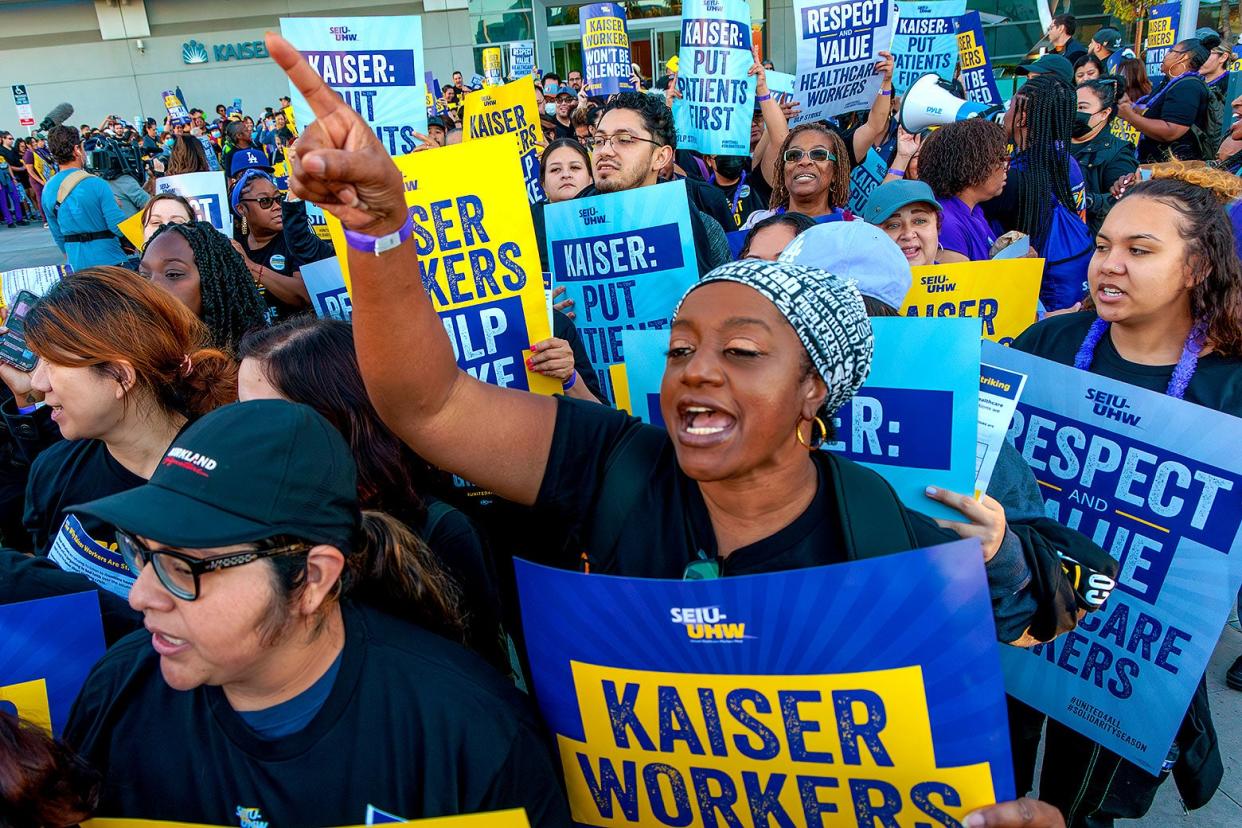Kaiser Permanente Used to Be America’s Model Health Care Employer. What Happened?

For more than 25 years, Kaiser Permanente had a successful partnership with its workers’ union, working hand in hand to secure some of the highest wages in the health care industry while providing high-quality patient care—until now. Over 75,000 workers are striking against the company, and their demands reflect the dire state of the U.S. health care system.
After months of failed contract negotiations, on Sept. 22, the Coalition of Kaiser Permanente Unions issued a 10-day unfair labor practice strike notice. The unions are negotiating their first contract since the COVID-19 pandemic began, and they say that working conditions have become untenable and are impacting patient care. “We’ve repeatedly raised our concerns with Kaiser executives about the Kaiser short-staffing crisis, but they are bargaining in bad faith and refusing to listen to us,” said Audrey Cardenas Loera, an administrative specialist at Kaiser Permanente in Oregon, in a union press release.
So on Wednesday, thousands of health care workers began a three-day strike across the area in which Kaiser Permanente operates—California, Colorado, Washington, Virginia, Oregon, and Washington D.C.—made up of nurses, radiologists, X-ray technicians, receptionists, pharmacists, and hundreds of other roles. It’s scheduled to go until Oct. 7 while negotiations continue, but if a settlement isn’t reached by then, the union has threatened another strike in November.
It’s a dramatic turnaround for Kaiser Permanente, which at one point had a rare and admirable relationship with its workers’ union. In the late 1990s, the health care company struck a labor-management partnership that gave the union a say during decision-making at all levels, from the boardroom to the operating room. The partnership blossomed into success for both parties.
“This strike is a big blow to that long-lasting, well-documented, really important example of the ability of labor and management to work together,” explained Ariel Avgar, director of the Center for Applied Research on Work at Cornell University.* “The labor–management partnerships can have strikes, they have adversarial relationships at times, but given the scale and size of this, it’s a big deal.”
There are two issues that are driving the current strike: wages and staffing. Under the unions’ last contract, members’ wage increases were linked to Kaiser Permanente’s financial goals, so if the company succeeded, workers would also be rewarded. But the unions want to do away with that pay structure and establish a flat minimum wage of $25 an hour (an increase), plus annual across-the-board raises for workers in every Kaiser Permanente region for the next four years. The workers also want increased funding for members’ retirement accounts and career development programs.
Kaiser Permanente has agreed to some of these demands, including the across-the-board wage increases in all of its markets over the next four years. However, it only offered to increase minimum wages up to $23 an hour in California and $21 for all other markets it operates in.
Aside from money, the union is also seeking relief from exhaustion and burnout among its members, especially from the grind of treating COVID-19. “The strain on the remaining understaffed workforce is almost unbearable,” said a 2022 union newsletter. But it’s not just COVID. Health care workers at Kaiser Permanente have also relayed stories of patients having to wait unsafe lengths of time to get cancer screenings, hospital room assignments, X-rays, surgeries, and more. These issues have only been amplified since the pandemic, which drove thousands of health care workers to leave their professions. The Kaiser Permanente union says there is “record attrition and tens of thousands of vacancies.”
Staffing shortages have plagued nearly all health care providers. Since February 2020, hospital employment has decreased by nearly 94,000, with annual staff turnover increasing from 18 percent up to 30 percent. At the same time, hospitals’ labor expenses have increased almost 16 percent since 2019. The American Hospital Association predicts there will be a shortage of 3.2 million health care workers by 2026.
Kaiser is a nonprofit organization, meaning it pays no income taxes on its earnings and limited property taxes, but it has still maintained record profits. Over the past five years the company has reported more than $24 billion in profit—six months into 2023, it reported $3 billion in profit.
But in response to the unions’ calls for more staffing, Kaiser Permanente has said they’ve met their goal of hiring 10,000 new staff members by the end of the year, and that over the past two years, they’ve hired more than 50,000 people. However, the company also says it’s not done yet, committing to address “every area of staffing that is still challenging.”
This pledge, though, did not stop the more than 60,000 union members who voted to strike against Kaiser Permanente, 98 percent of its West Coast arm. That’s notable, as Ken Wong, director of the University of California, Los Angeles’ labor center, explained: “These are people that work every day caring for their patients. This is not a light decision, and yet it is a reflection of the level of discontent and the level of frustration that many of these workers feel.”
And they’re not alone, as they were joined by an earlier nurses strike in New York City, the Hollywood writers strike that lasted 148 days, numerous teachers strikes across the country, and the ongoing actors and United Auto Workers strikes. It’s a trend that started even before this year though: The Bureau of Labor Statistics found major strike activity in the U.S. increased nearly 50 percent in 2022.

